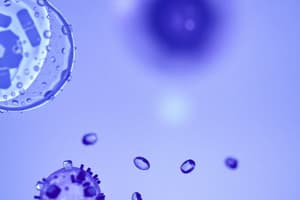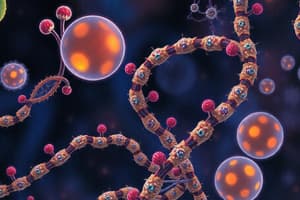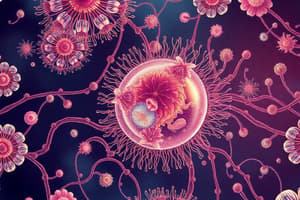Podcast
Questions and Answers
Which statement accurately describes prokaryotic cells?
Which statement accurately describes prokaryotic cells?
- They have a defined nucleus.
- They are typically smaller than eukaryotic cells. (correct)
- They can be unicellular or multicellular.
- They contain membranous organelles.
What is the primary component of the cell wall in prokaryotic cells?
What is the primary component of the cell wall in prokaryotic cells?
- Cellulose
- Chitin
- Peptidoglycan (correct)
- Lignin
What feature distinguishes Gram-positive bacteria from Gram-negative bacteria?
What feature distinguishes Gram-positive bacteria from Gram-negative bacteria?
- Shape of bacteria
- Thicker cell wall (correct)
- Capsule presence
- Presence of ribosomes
What type of genetic material is found in prokaryotic cells?
What type of genetic material is found in prokaryotic cells?
Which of the following is NOT a characteristic of eukaryotic cells?
Which of the following is NOT a characteristic of eukaryotic cells?
What is a distinctive feature of eukaryotic cells?
What is a distinctive feature of eukaryotic cells?
What is the function of cilia on eukaryotic cells?
What is the function of cilia on eukaryotic cells?
Which component is NOT part of the eukaryotic interior structure?
Which component is NOT part of the eukaryotic interior structure?
What arrangement do primary cilia have?
What arrangement do primary cilia have?
What is the primary component of the plant cell wall?
What is the primary component of the plant cell wall?
Which feature distinguishes flagella from cilia?
Which feature distinguishes flagella from cilia?
Which structure is NOT involved in providing shape and support in eukaryotic cells?
Which structure is NOT involved in providing shape and support in eukaryotic cells?
Which of the following describes the plasma membrane?
Which of the following describes the plasma membrane?
What is the role of the basal body in cilia and flagella?
What is the role of the basal body in cilia and flagella?
Which of the following does NOT apply to eukaryotic cells?
Which of the following does NOT apply to eukaryotic cells?
Flashcards
Prokaryotes
Prokaryotes
Single-celled organisms lacking a nucleus and other membrane-bound organelles. They are typically smaller and simpler than eukaryotic cells. Examples include bacteria and archaea.
Gram-positive bacteria
Gram-positive bacteria
Bacteria with a thicker peptidoglycan cell wall that retains the Gram stain, appearing purple under a microscope.
Mesosomes
Mesosomes
Infoldings of the plasma membrane in prokaryotes, serving as the site of cellular respiration.
Plasmid
Plasmid
Signup and view all the flashcards
Eukaryotes
Eukaryotes
Signup and view all the flashcards
Eukaryotic cells
Eukaryotic cells
Signup and view all the flashcards
Prokaryotic cells
Prokaryotic cells
Signup and view all the flashcards
Cell wall
Cell wall
Signup and view all the flashcards
Plasma membrane
Plasma membrane
Signup and view all the flashcards
Cilia
Cilia
Signup and view all the flashcards
Flagella
Flagella
Signup and view all the flashcards
Cytoplasm
Cytoplasm
Signup and view all the flashcards
Cytoskeleton
Cytoskeleton
Signup and view all the flashcards
Endomembrane system
Endomembrane system
Signup and view all the flashcards
Mitochondria
Mitochondria
Signup and view all the flashcards
Study Notes
Cell Structure and Functions
- Cells are the basic units of life.
- Studying cells involves prokaryotes and eukaryotes, cell structures, and organelles.
- Transport across cell membranes is also a key aspect.
Prokaryotes (Prokaryotic Cells)
- Prokaryotes are single-celled organisms.
- They are the smallest and simplest cells, typically ranging from 1 to 10 µm in size.
- Examples include bacteria and archaebacteria.
- Their cytoplasm/protoplasm is enclosed by a plasma membrane.
- They lack a cytoskeleton.
- The cell wall is made of peptidoglycan, which maintains cell shape.
- Gram-negative bacteria have thinner cell walls and do not retain the Gram stain.
- Gram-positive bacteria retain the Gram stain (purple).
- Some prokaryotes have capsules to limit phagocytosis.
- They lack membrane-bound organelles.
- Mesosomes are infoldings of the plasma membrane, involved in cellular respiration.
- Prokaryotes contain ribosomes for protein synthesis.
- Some prokaryotes have flagella for movement and pili for attachment.
- Genetic material is "naked" circular DNA (nucleoid).
- Some have plasmids (small circular DNA) storing important genes, such as antibiotic resistance.
- Prokaryotes have a high metabolic and growth rate, and a short lifespan.
- Reproduction occurs through binary fission.
Eukaryotes (Eukaryotic Cells)
- Eukaryotic cells include animal and plant cells. They can be unicellular or multicellular.
- Eukaryotic cells are larger, ranging from 10 to 100 µm.
- They are bounded by plasma membranes.
- Eukaryotic cells contain a distinct nucleus enclosed by a nuclear envelope.
- They have membrane-bound organelles.
- They possess a cytoskeleton for structural support and intracellular movement.
- Flagella are more complex in eukaryotes.
- Eukaryotic cells reproduce through meiosis and mitosis.
The Cell and Organelles
- Exterior structure:
- Cell wall (in plants and some bacteria)
- Plasma membrane (encloses the cytoplasm, semi-permeable)
- Cilia and flagella (projections for movement and other functions)
- Interior structure:
- Cytoplasm (the jelly-like substance inside the cell)
- Cytoskeleton (in eukaryotes)
- Organelles (specialized structures within the cell - endomembrane system, mitochondria, chloroplasts, ribosomes, and the nucleus)
Cell Wall
- Found in plants and some bacteria and protists.
- Provides support and protection.
- Plants - made of cellulose.
- Bacteria - made of peptidoglycan.
Plasma Membrane
- Encloses the cytoplasm.
- A phospholipid bilayer with embedded proteins.
- Semi-permeable (selectively permeable).
- Functions include separating the cell's interior from the environment, shape maintenance, cell adhesion, ion channel activity, cell signaling, and cytoskeleton attachment points.
Cilia
- Projections from the cell surface.
- Motile (move) or non-motile (primary).
- Primary cilia are present on nearly every cell in the human body.
- Function in movement and sensory reception.
- Microtubules (hollow cylinders formed from protein) are the structural components of cilia. The arrangement and positioning of microtubules determine cilia function. Primary cilia (9+0) are typically non-motile, whereas motile cilia (9+2) facilitate rhythmic beating.
Flagella
- Projections from the cell.
- Usually longer than cilia.
- Made of microtubules covered by a plasma membrane (9+2 arrangement).
- Involved in cell movement.
Differences between prokaryotic and eukaryotic cells
- Prokaryotic cells are smaller and simpler with no nucleus or membrane-bound organelles.
- Eukaryotic cells are larger and more complex, have a nucleus and membrane-bound organelles, and are more diverse.
Studying That Suits You
Use AI to generate personalized quizzes and flashcards to suit your learning preferences.




